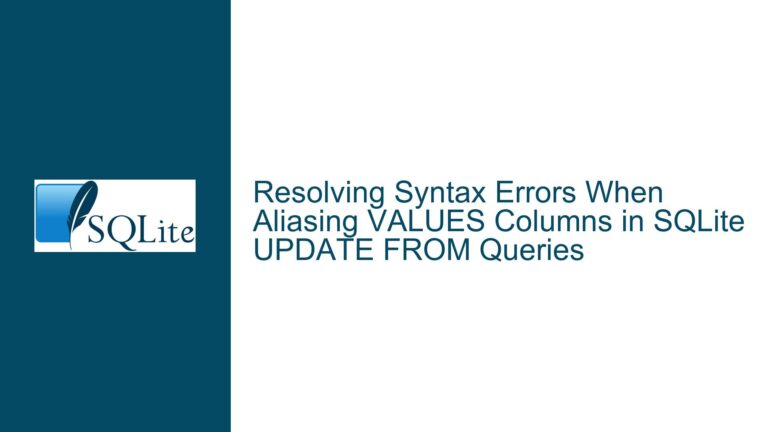Selecting Articles with Multiple Keywords in SQLite: A Comprehensive Guide
Understanding the Need for Selecting Articles with Multiple Keywords
In database management, particularly when dealing with content-rich applications like article repositories, the ability to filter records based on multiple criteria is essential. A common requirement is to select articles that are associated with multiple specific keywords. This scenario is not just about fetching data but ensuring that the data fetched meets a compound condition that reflects the intersection of multiple attributes.
The challenge intensifies when the database schema involves multiple related tables, such as docs, keywords, and authors. Each table holds a piece of the puzzle, and the relationships between these tables must be navigated carefully to construct accurate and efficient queries. The primary goal here is to retrieve articles that are tagged with all specified keywords, not just any one of them.
The Complexity of Using AND with LIKE in SQL Queries
The initial approach to solving this problem might involve using the AND operator in conjunction with the LIKE clause in SQL. However, this approach is fraught with complications due to the nature of SQL’s logical operations. The AND operator requires that all conditions be true simultaneously, which is straightforward when dealing with direct comparisons but becomes problematic when the conditions involve pattern matching across multiple rows.
In the context of the provided schema, each keyword is stored in a separate row within the keywords table. This means that a single article can have multiple keyword associations, each represented by a distinct row. Therefore, attempting to use AND directly in a WHERE clause to match multiple keywords will not yield the desired results because it implies that a single row must satisfy all conditions simultaneously, which is impossible given the schema design.
Exploring Solutions: INTERSECT, CTEs, and Sub-queries
To address this challenge, several advanced SQL techniques can be employed. The INTERSECT operator is particularly useful as it allows the combination of results from multiple SELECT statements, returning only the rows that are common to all result sets. This is ideal for finding articles that are associated with multiple keywords, as each SELECT statement can target a different keyword, and the INTERSECT operation will filter down to those articles that appear in all subsets.
Common Table Expressions (CTEs) offer another powerful tool. By defining a temporary result set that can be referenced within a larger query, CTEs simplify complex queries and improve readability. In this scenario, a CTE can be used to first identify all articles associated with one keyword and then join this result with another CTE or sub-query that identifies articles associated with a second keyword.
Sub-queries also provide a mechanism to nest queries, allowing for the execution of a query within another query. This can be particularly useful for counting the number of keyword matches per article and then filtering based on this count. For example, a sub-query can be used to count how many of the specified keywords are associated with each article, and the outer query can then filter to include only those articles where the count matches the number of specified keywords.
Implementing the Solutions: Practical Examples
Let’s delve into practical implementations of these solutions. Using the INTERSECT operator, the query structure would involve multiple SELECT statements, each targeting a different keyword, combined with INTERSECT to find common articles. This method is straightforward but can become cumbersome with an increasing number of keywords.
With CTEs, the approach involves defining a temporary result set for each keyword and then joining these sets to find articles that appear in all. This method enhances readability and maintainability, especially as the complexity of the query grows.
Sub-queries offer a more dynamic approach, particularly when the number of keywords is variable. By using a sub-query to count keyword matches, the outer query can dynamically adjust to the number of keywords specified, making this method highly flexible.
Optimizing the Database Schema for Keyword Searches
While the above solutions address the immediate querying challenge, it’s also crucial to consider the underlying database schema’s role in facilitating or hindering such queries. Normalization plays a key role here. A well-normalized database reduces redundancy and improves data integrity, but it can also complicate queries that span multiple tables.
In the context of keyword searches, ensuring that keywords are uniquely identified and consistently referenced across tables can significantly streamline query construction. This might involve creating a dedicated table for keywords with unique identifiers and establishing many-to-many relationships between articles and keywords through a linkage table. Such a structure not only supports more efficient querying but also enhances the database’s scalability and flexibility.
Conclusion: Best Practices for Complex Queries in SQLite
Selecting articles with multiple keywords in SQLite requires a nuanced understanding of SQL’s capabilities and limitations. By leveraging operators like INTERSECT, utilizing CTEs for better query structure, and employing sub-queries for dynamic filtering, complex data retrieval tasks become manageable. Additionally, optimizing the database schema to support these queries is essential for maintaining performance and scalability.
As database systems continue to evolve, so too do the techniques for managing and querying data. Staying informed about these developments and understanding the underlying principles of database design and query optimization are key to effectively managing complex data retrieval tasks in SQLite and beyond.






